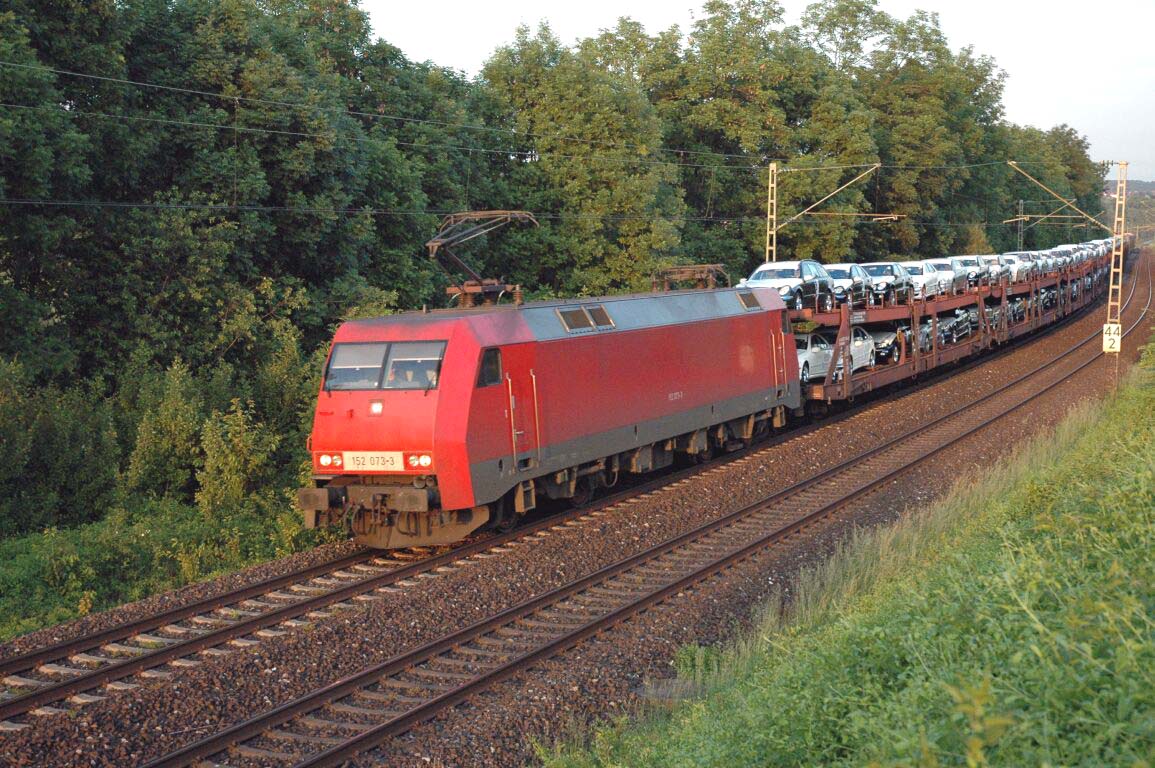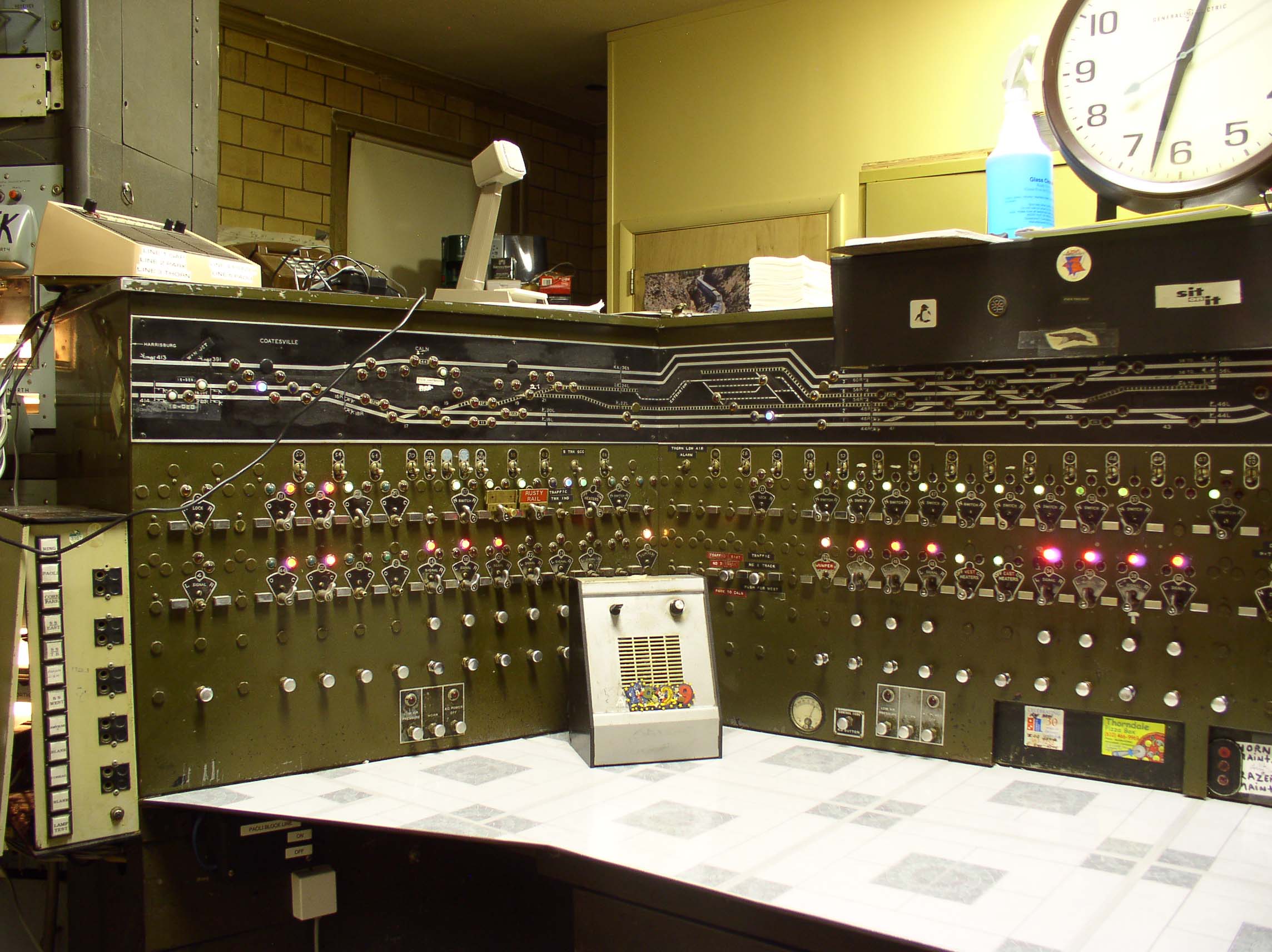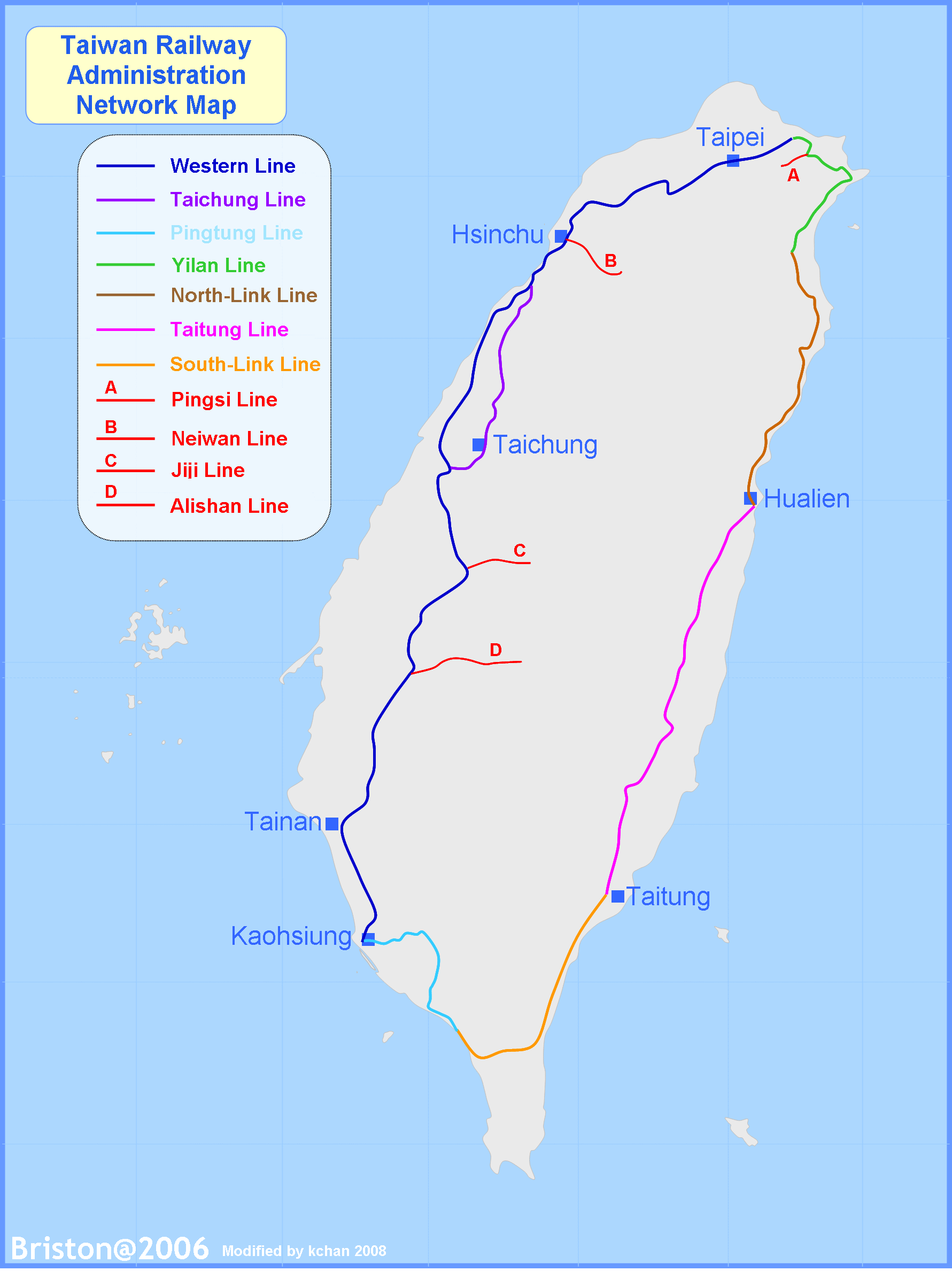|
Taiwan Railways Administration
Taiwan Railways Administration (TRA) is a railway operator in Taiwan. It is an agency of the Ministry of Transportation and Communications, responsible for managing, maintaining, and running conventional passenger and freight railway services on 1097 km of track in Taiwan. Since Taiwan is heavily urbanised with a high population density, railways have played an important part in domestic transportation since the late 19th century. Passenger traffic in 2018 was 231,267,955. The agency's headquarters are in Zhongzheng District, Taipei. Overview Railway services between Keelung and Hsinchu began in 1891 under China's Qing dynasty. Because the railway was completely rebuilt and substantially expanded under the operated by Formosa's Japanese colonial government (1895–1945), the network's Japanese influence and heritage persists. Similarities between the TRA and the Japan Railways (JR) companies can be noted in signal aspects, signage, track layout, fare controls, ... [...More Info...] [...Related Items...] OR: [Wikipedia] [Google] [Baidu] |
Chang Chen-yuan
Chang Chen-yuan (), also known by his English name Michael Chang, is a Taiwanese politician. He graduated from the Department of Transportation and Logistics Management at National Chiao Tung University with a doctorate and served as station master at Taipei Main Station from 1987 to 1991. Chang later successively assumed several public service posts relating to public transportation and tourism. Such positions included leading the tourism division of the Taipei Economic and Cultural Office in New York, a stint as director of the Southwest Coast National Scenic Area, and within Tainan City Government as municipal Bureau of Transportation director and the city's deputy mayor under William Lai. Chang became political deputy minister of transportation and communications after Lai assumed the premiership. As a result of the derailment of a Puyuma express train in October 2018, Taiwan Railways Administration Taiwan Railways Administration (TRA) is a railway operator in Taiwan. It ... [...More Info...] [...Related Items...] OR: [Wikipedia] [Google] [Baidu] |
Taiwan Under Japanese Rule
The island of Taiwan, together with the Penghu Islands, became a dependency of Japan in 1895, when the Qing dynasty ceded Fujian-Taiwan Province in the Treaty of Shimonoseki after the Japanese victory in the First Sino-Japanese War. The short-lived Republic of Formosa resistance movement was suppressed by Japanese troops and quickly defeated in the Capitulation of Tainan, ending organized resistance to Japanese occupation and inaugurating five decades of Japanese rule over Taiwan. Its administrative capital was in Taihoku (Taipei) led by the Governor-General of Taiwan. Taiwan was Japan's first colony and can be viewed as the first step in implementing their " Southern Expansion Doctrine" of the late 19th century. Japanese intentions were to turn Taiwan into a showpiece "model colony" with much effort made to improve the island's economy, public works, industry, cultural Japanization, and to support the necessities of Japanese military aggression in the Asia-Pacific. T ... [...More Info...] [...Related Items...] OR: [Wikipedia] [Google] [Baidu] |
Hualien City
Hualien City (; Wade-Giles: Hua¹-lien² Shih⁴; Hokkien POJ: ''Hoa-lian-chhī'' or ''Hoa-liân-chhī'') is a county-administered city and the county seat of Hualien County, Taiwan. It is located on the east coast of Taiwan on the Pacific Ocean, and has a population of 106,368 inhabitants. Name Hualien County annals () record that the city was called "Kilai" () until the early twentieth century. This name refers to the Sakiraya Taiwanese aborigines and their settlement. After Taiwan came under Japanese rule in 1895 its governors sought to change the name because "Kilai" is pronounced the same as the Japanese word for . The name was eventually changed to . After World War II the incoming Kuomintang-led Republic of China retained the Kanji spelling but shortened the name to just , or ''Hualien'' via Chinese romanization. History The Spaniards built mines for gold in Hualien in 1622. Permanent settlements began in 1851, when 2,200 Han Chinese farmers led by Huang A-fong (黃 ... [...More Info...] [...Related Items...] OR: [Wikipedia] [Google] [Baidu] |
Unit Train
A unit train, also called a block train or a trainload service, is a train in which all cars (wagons) carry the same commodity and are shipped from the same origin to the same destination, without being split up or stored en route. They are distinct from wagonload trains, which comprise differing numbers of cars for various customers. Unit trains enable railways to compete more effectively with road and internal waterway transport systems. Time and money is saved by avoiding the complexities and delays that would otherwise be involved with assembling and disassembling trains at rail yards near the origin and destination. Unit trains are particularly efficient and economical for high-volume commodities. Since they often carry only one commodity, cars are of all the same type; often the cars are identical. Use Unit trains are typically used for the transportation of bulk goods. These can be solid substances such as: * Track ballast or gravel * Iron ore from mines to ports or s ... [...More Info...] [...Related Items...] OR: [Wikipedia] [Google] [Baidu] |
On-time Performance
In public transportation, schedule adherence or on-time performance refers to the level of success of the service (such as a bus or train) remaining on the published schedule. On time performance, sometimes referred to as on time running, is normally expressed as a percentage, with a higher percentage meaning more vehicles are on time. The level of on time performance for many transport systems is a very important measure of the effectiveness of the system. Background On time performance is a measure of the ability of transport services to be on time. Almost all transportation systems have timetables, which describe when vehicles are to arrive at scheduled stops. Transport services have a higher utility where services run on time, as anyone planning on making use of the service can align their activities with that of the transport system. On time performance is particularly important where services are infrequent, and people need to plan to meet services. The ability of different ... [...More Info...] [...Related Items...] OR: [Wikipedia] [Google] [Baidu] |
Taiwan High Speed Rail
Taiwan High Speed Rail (THSR) is the high-speed railway of Taiwan consisting of one line that runs approximately along the west coast, from the capital Taipei to the southern city of Kaohsiung. With construction and operations managed by a private company, Taiwan High Speed Rail Corporation (THSRC; ), which also operates the line, the total cost of the project was billion in 1998. At the time it was built, this was one of the world's largest privately funded rail construction schemes. The system is based primarily on Japan's Shinkansen. The railway opened for service on 5 January 2007, with trains running at a top speed of , currently running from Nangang to Zuoying in as little as 1 hour and 45 minutes, reaching almost 90% of Taiwan's population. Most intermediate stations on the line lie outside the cities served; however, a variety of transfer options, such as free shuttle buses, conventional rail, and metros have been constructed to facilitate transport connections. Rid ... [...More Info...] [...Related Items...] OR: [Wikipedia] [Google] [Baidu] |
South-link Line
The South-link line () is a line of the Taiwan Railways Administration running across the southern tip of the island of Taiwan, connecting the eastern and western coasts. It is 98.2 km long, of which 81.4 km is single-track. The section between Nanzhou and Linbian railway stations was upgraded from a single-track railway to a dual-track railway while the other sections remains in single-track. In conjunction with electrification works on the line, train platforms are being lengthened and upgraded with better facilities. History Japanese authorities had planned for a railway running between Pingtung and Taitung, but were unable to complete it before World War II ended. After the Kuomintang-led government took control, surveys were completed in 1947, 1958, 1963, 1968, and 1976, delineating ten possible routes for the South Link Line. Construction began in July 1980, and was completed in November 1991. Upon its inauguration on 16 December 1991, the South Link Line b ... [...More Info...] [...Related Items...] OR: [Wikipedia] [Google] [Baidu] |
Centralized Traffic Control
Centralized traffic control (CTC) is a form of railway signalling that originated in North America. CTC consolidates train routing decisions that were previously carried out by local signal operators or the train crews themselves. The system consists of a centralized train dispatcher's office that controls railroad interlockings and traffic flows in portions of the rail system designated as CTC territory. One hallmark of CTC is a control panel with a graphical depiction of the railroad. On this panel, the dispatcher can keep track of trains' locations across the territory that the dispatcher controls. Larger railroads may have multiple dispatcher's offices and even multiple dispatchers for each operating division. These offices are usually located near the busiest yards or stations, and their operational qualities can be compared to air traffic towers. Background Key to the concept of CTC is the notion of ''traffic control'' as it applies to railroads. Trains moving in opposite ... [...More Info...] [...Related Items...] OR: [Wikipedia] [Google] [Baidu] |
West Coast Line (Taiwan)
Western Trunk line () is a railway line of the Taiwan Railways Administration in western Taiwan. It is by far the busiest line, having served over 171 million passengers in 2016. The total length of the line is 404.5 km. The line is an official classification of physical tracks and does not correspond to particular services. It is connected to Taichung line (''mountain line''; ) at Zhunan and Changhua. Many services turn inland to take the Taichung route, then reconnect back to the main line (West Coast line). Train schedules and departure boards mark either ''mountain'' or ''coastal'' () line to indicate the route taken. History The original railroad between Keelung and Twatutia was completed in 1891. The section between Twatutia and Hsinchu was finished in 1893. However, in the Japanese era, these sections were all rebuilt by the Government-General of Taiwan as part of its Taiwan Trunk Railway (, ''Jūkan Tetsudō'') project. The Taiwan Trunk Railway was completed in ... [...More Info...] [...Related Items...] OR: [Wikipedia] [Google] [Baidu] |
Track Gauge
In rail transport, track gauge (in American English, alternatively track gage) is the distance between the two rails of a railway track. All vehicles on a rail network must have wheelsets that are compatible with the track gauge. Since many different track gauges exist worldwide, gauge differences often present a barrier to wider operation on railway networks. The term derives from the metal bar, or gauge, that is used to ensure the distance between the rails is correct. Railways also deploy two other gauges to ensure compliance with a required standard. A '' loading gauge'' is a two-dimensional profile that encompasses a cross-section of the track, a rail vehicle and a maximum-sized load: all rail vehicles and their loads must be contained in the corresponding envelope. A '' structure gauge'' specifies the outline into which structures (bridges, platforms, lineside equipment etc.) must not encroach. Uses of the term The most common use of the term "track gauge" refers to t ... [...More Info...] [...Related Items...] OR: [Wikipedia] [Google] [Baidu] |
Air Raids On Japan
Air raids conducted by Allied forces on Japan during World War II caused extensive destruction to the country's cities and killed between 241,000 and 900,000 people. During the first years of the Pacific War these attacks were limited to the Doolittle Raid in April 1942 and small-scale raids on military positions in the Kuril Islands from mid-1943. Strategic bombing raids began in June 1944 and continued until the end of the war in August 1945. Allied naval and land-based tactical air units also attacked Japan during 1945. The United States military air campaign waged against Japan began in earnest in mid-1944 and intensified during the war's last months. While plans for attacks on Japan had been prepared prior to the Pacific War, these could not begin until the long-range B-29 Superfortress bomber was ready for combat. From June 1944 until January 1945, B-29s stationed in India staged through bases in China to make a series of nine raids on targets in western Japan, but thi ... [...More Info...] [...Related Items...] OR: [Wikipedia] [Google] [Baidu] |
World War II
World War II or the Second World War, often abbreviated as WWII or WW2, was a world war that lasted from 1939 to 1945. It involved the World War II by country, vast majority of the world's countries—including all of the great powers—forming two opposing military alliances: the Allies of World War II, Allies and the Axis powers. World War II was a total war that directly involved more than 100 million Military personnel, personnel from more than 30 countries. The major participants in the war threw their entire economic, industrial, and scientific capabilities behind the war effort, blurring the distinction between civilian and military resources. Air warfare of World War II, Aircraft played a major role in the conflict, enabling the strategic bombing of population centres and deploying the Atomic bombings of Hiroshima and Nagasaki, only two nuclear weapons ever used in war. World War II was by far the List of wars by death toll, deadliest conflict in hu ... [...More Info...] [...Related Items...] OR: [Wikipedia] [Google] [Baidu] |







